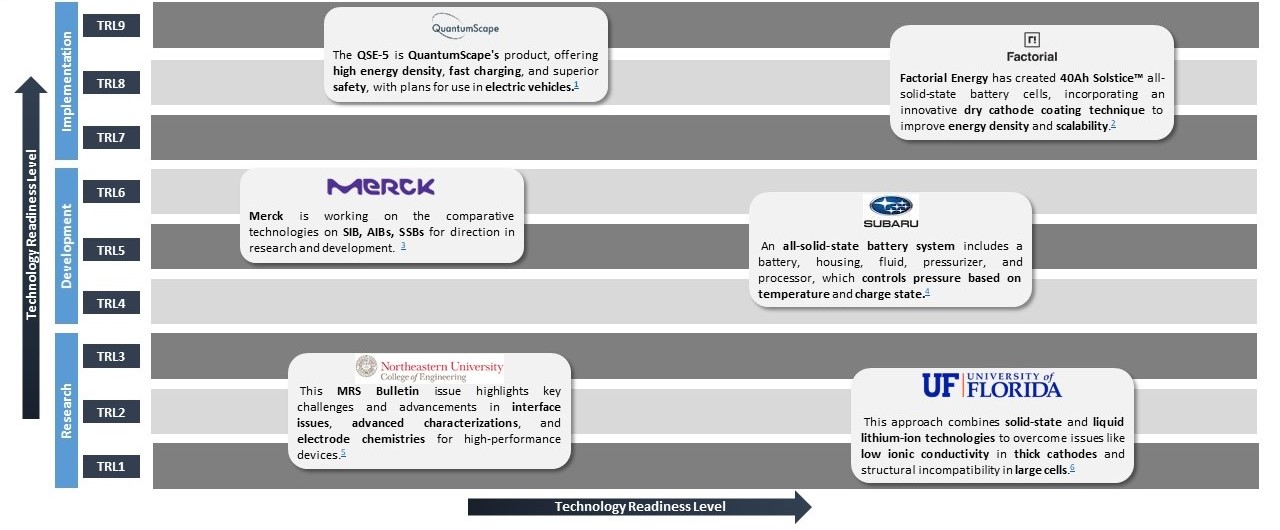Solid-State Batteries: Overview

Solid State Battery: Overview
The solid-state battery (SSB) industry is transforming, driven by advanced technologies and rising demand across applications. Offering breakthroughs in safety and energy density, SSBs could reach a US$9 billion market by 2035.
Basic Working Principle
The basic working principle of a solid-state battery (SSB) involves lithium ions moving through a solid electrolyte.
- Solid Electrolyte: Replaces liquid for improved safety.
- Ion Movement: Lithium ions transfer during charge and discharge.
- Compact Design: Enables smaller, more efficient batteries.
SSB Hierarchy
- Thermal Resilience
- Elevated Energy Density
- High Tolerance
- Non-Volatile Electrolyte
- Non-Combustible
SSB Advantages
- More Energy Storage
- Lighter Batteries
- Quick Ion Movement
- Good Heat Resistance
- High Charge Efficiency
- Enhanced Design Flexibility
SSB Dynamics
Solid-state batteries (SSBs) replace liquid electrolytes with solid materials, improving safety and energy density. The development focuses on three electrolyte types:
- Sulphides: High ionic conductivity, but toxicity and manufacturing challenges.
- Polymers: Scalable but require higher temperatures and face stability issues.
- Oxides: Excellent stability for lithium metal anodes, but high interface resistance and costs.
- Each electrolyte type offers distinct trade-offs in performance, cost, and scalability.
SSB Applications
- Satellite
- Chemicals
- Industrial Storage
- Electronics
- Automobile
Solid State Battery Market Size, Share, and Trends 2024 to 2030
Global Market Share
Demand for high-performance, safe, and efficient power sources across various industries.
- Consumer Electronics: Drives demand for compact, long-lasting power sources with better safety for thinner devices and longer use.
- Electric vehicles (EVs): Emphasizing high-energy-density batteries for better range, fast charging, and reduced weight.
- Medical devices: Solid-state batteries offer stable performance and reduced leakage risk, critical for reliability and safety in medical applications.
Market Scope
Global solid-state battery market, valued at USD 1.63 billion in 2025, is projected to reach USD 26.03 billion by 2034, growing at a CAGR of 36.03%.
The solid-state battery market is projected to grow at a rate of 56.6% from 2025 to 2030.
Battery Type Insight
- Thin film battery segment dominated the solid-state market with 89.8% revenue share in 2024.
- Portable battery segment is projected to grow at a 53.9% CAGR due to rising demand for energy-efficient electronics.
Capacity Insight
- The below 20mAh capacity segment is projected to grow at the highest CAGR of 62.7% from 2025 to 2030.
- The 20mAh-500mAh capacity segment led the market and held the largest revenue share of 62.6% in 2024.
Recent Development
Volkswagen partners with QuantumScape to mass-produce all-solid-state batteries (ASSBs) for EVs.
- Benefits of ASSBs: Increased range, faster charging times, improved 0-62 acceleration, and potentially higher top speeds.
- Production goal: VW aims to produce up to 40 GWh of batteries annually, enough for 1 million cars, with potential to scale to 80 GWh in the future.
Top Players

Solid State Battery: Research, Development & Implementation
The development of solid-state batteries progresses from the research phase, focusing on material innovation and design, to implementation, where scaling and commercial production are prioritized.

Read Also: Solid-State Battery Innovation
Solid State Battery: Advantages, Challenges, and Potential Opportunities
SWOT analysis is performed for Solid state battery to assess the strengths, weaknesses, opportunities, and threats of a project, product, or business.
Strengths:
- Enhanced Battery Storage Mediums
- Improved Safety
- Faster Charging
- Long Lifespan
- Reduces Environmental Hazard
Weaknesses:
- Material Limitation
- Manufacturing Challenges
- High Production Cost
- Intricate Manufacturing Process
- Limited Commercial Availability
Opportunities:
- Significant Market Growth
- Diverse Application
- Government Incentives
- Strategic OEMs Partnerships
- Lowered Cost and Increased reliability
Threats:
- Intense Competition
- Regulatory Hurdles
- Supply Chain Constraints
- Economic Downturns
- Market Adoption
About Effectual Services
Effectual Services is an award-winning Intellectual Property (IP) management advisory & consulting firm offering IP intelligence to Fortune 500 companies, law firms, research institutes and universities, and venture capital firms/PE firms, globally. Through research & intelligence we help our clients in taking critical business decisions backed with credible data sources, which in turn helps them achieve their organisational goals, foster innovation and achieve milestones within timelines while optimising costs.
We are one of the largest IP & business intelligence providers, globally serving clients for over a decade now. Our multidisciplinary teams of subject matter experts have deep knowledge of best practices across industries, are adept with benchmarking quality standards and use a combination of human and machine intellect to deliver quality projects. Having a global footprint in over 5 countries helps us to bridge boundaries and work seamlessly across multiple time zones, thus living to the core of our philosophy - Innovation is global, so are we !!!
Solutions Driving Innovation & Intelligence
Enabling Fortune 500's, R&D Giants, Law firms, Universities, Research institutes & SME's Around The Globe Gather Intelligence That
Protects and Nurtures Innovation Through a Team of 250+ Techno Legal Professionals.


